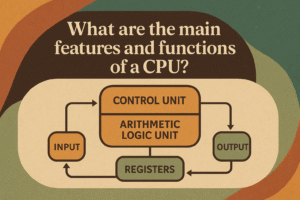Features and Functions of CPU – Explained in Simple English
The CPU (Central Processing Unit) is often called the brain of the computer. It takes information from the memory and processes it to perform tasks. Companies like Intel and AMD are popular for making CPUs.
Let’s understand the main features and functions of a CPU in simple terms.
Key Features of CPU
1. Cache Memory
Cache is a small but very fast memory located inside the CPU. It helps the CPU access data quickly without going to the main memory every time. The cache stores frequently used information and sends it to the CPU for faster processing.
There are three levels of cache memory:
-
L1 Cache – Smallest but fastest
-
L2 Cache – Larger than L1 but slightly slower
-
L3 Cache – Largest among all but slower than L1 and L2
Each level helps improve the overall speed and efficiency of the CPU.
2. CPU Cores
Modern CPUs have multiple cores, which allow them to perform multiple tasks at the same time (called parallel processing). More cores mean better multitasking and performance.
Each core has its own cache memory and can communicate with other cores when needed. This makes the computer work faster and more efficiently.
3. CPU Speed
The speed of a CPU is measured in GHz (Gigahertz) or MHz (Megahertz). This shows how many instructions the CPU can execute per second. A higher frequency means faster performance.
For example, a 3.5 GHz CPU can handle more tasks in less time compared to a 2.0 GHz CPU.
4. Multithreading
Multithreading is a feature that allows each physical CPU core to act like two logical cores. This improves the CPU’s ability to handle multiple operations simultaneously.
Thanks to multithreading, the CPU becomes more efficient and completes tasks faster.
5. Bandwidth
Bandwidth refers to the speed at which the CPU communicates with memory and input/output devices (like mouse, keyboard, printer, etc.).
Communication happens through circuits such as:
-
PCI slots for connecting PCI cards
-
USB controllers for USB devices
CPUs with more cores usually have higher bandwidth, allowing faster data exchange. For example, AMD CPUs often have higher bandwidth compared to some Intel CPUs.
Main Functions of CPU
The CPU performs four main functions in every processing cycle:
1. Fetch
The CPU picks (fetches) the instruction stored in memory using its address.
2. Decode
The fetched instruction is converted into binary code so that the CPU can understand it.
3. Execute
The CPU then executes the instruction and performs the desired operation.
4. Store
Finally, the result of the executed instruction is stored back in memory for future use.
Conclusion
The CPU plays a vital role in making a computer work efficiently. Its features like cache memory, multiple cores, multithreading, and speed make it powerful. By understanding these basic concepts, you can better appreciate how computers process information so quickly and smoothly.
Features of CPU in hindi (सीपीयू की विशेषताएं)
CPU कंप्यूटर का दिमाग होता है. यह मैमोरी से information को लेता है और उसे process करता है. Intel और AMD दो ऐसी कंपनियां है जो CPU का निर्माण करती है. सीपीयू के features निम्नलिखित होते है:-
- CPU की cache memory
cache एक छोटी मैमोरी होती है जो कि सीपीयू के अंतर स्थित रहती है. जिससे कि सीपीयू जल्दी से मैमोरी को access कर पाता है. cache मैमोरी, main मैमोरी से information को fetch करता है और इस सूचना को सीपीयू को प्रोसेसिंग के लिए भेज देता है.
cache मैमोरी जो है वह main memory से तेज होती है. इसमें तीन प्रकार की cache memory होती है.:- Layer1 (L1), layer2 (L2), layer3 (L3).
L1 जो है वह L2 से छोटी होती है और तेज होती है. जबकि L2 जो है वह L3 से छोटी होती है और तेज होती है.
- CPU के cores
सीपीयू के अंदर बहुत सारें cores होते है. और इनका प्रयोग parallel processing के कार्य के लिए किया जाता है. cores कंप्यूटर सिस्टम की efficiency (दक्षता) को बढ़ा देते हैं.
प्रत्येक core की अपनी एक खासियत होती है और उनके पास खुद की cache memory होती है. और जरूरत पड़ने पर एक core दुसरे cores से communicate भी कर सकता है.
- सीपीयू की speed (गति)
सीपीयू की speed को GHz (गीगाहेर्त्ज़) या MHz (मेगाहेर्त्ज़) में मापा जाता है. जहाँ हेर्त्ज़ (hertz) जो है वह फ्रीक्वेंसी की इकाई है.
वह सीपीयू जिसकी जितनी ज्यादा फ्रीक्वेंसी होगी वह उतने ही ज्यादा speed से tasks (कार्यों) को पूर्ण कर सकता है.
- सीपीयू में Multithreading
Multithreading के कारण ही सीपीयू parallel processing को सपोर्ट करता है. multithreading में, सीपीयू के प्रत्येक physical core में दो logical cores होते है. जो कि parallel में कार्य करते हैं.
इससे पूरी process की speed बढ़ जाती है.
- CPU की bandwidth
सीपीयू को input/output डिवाइस और मैमोरी से communicate करने के लिए एक सर्किट की आवश्यकता होती है जैसे:- PCI slots के द्वारा PCI cards से communicate किया जाता है और USB controllers से USB devices जैसे:- माउस, कीबोर्ड, प्रिंटर आदि के साथ communicate किया जाता है.
वह speed जिस पर यह communication होता है उसे हम bandwidth कहते है. और bandwidth हर cpu में अलग अलग होता है. जिस cpu के पास ज्यादा cores होंगी उसका bandwidth ज्यादा होगा. और जिसके पास कम cores होंगी उसका कम बैंडविड्थ होगा. .
AMD प्रोसेसर का बैंडविड्थ INTEL से ज्यादा होता है.
functions of CPU in hindi
इसके मुख्यतया निम्नलिखित 4 कार्य होते हैं:-
- Fetch:- प्रत्येक instruction मैमोरी में स्टोर रहता है और इनका अपना address होता है. इस address के द्वारा प्रोसेसर instruction को fetch करता है.
- Decode:- फिर इसके बाद इस instruction को बाइनरी कोड में डिकोड किया जाता है जिससे कि cpu को instruction समझ में आये.
- execute:- इसके बाद प्रोसेसर इसे execute करता है.
- store:- execution के बाद जो भी result प्राप्त होता है उसे मैमोरी में store कर दिया जाता है
